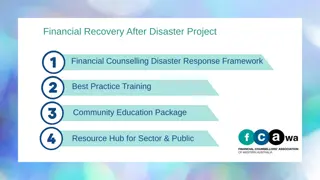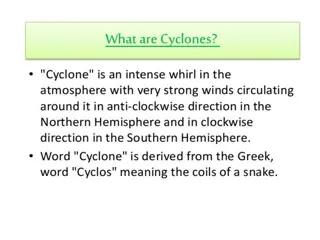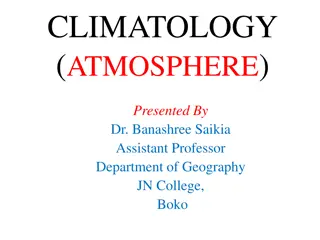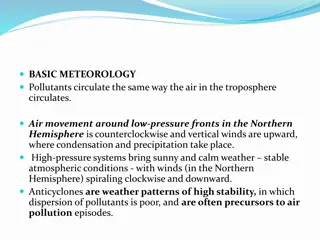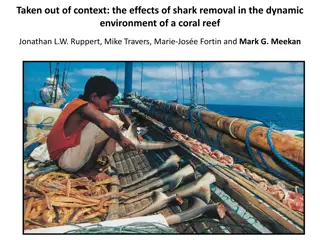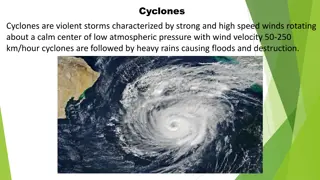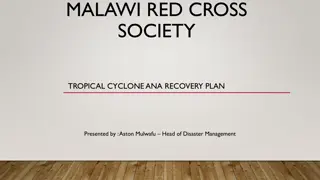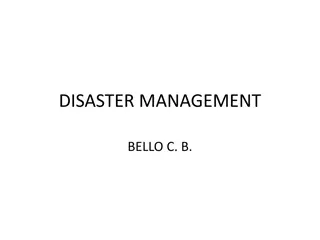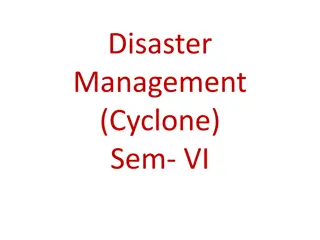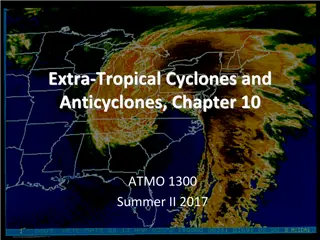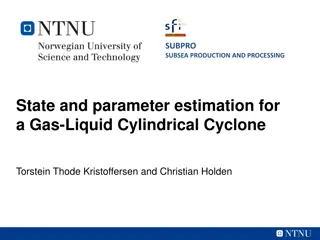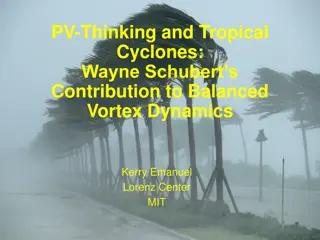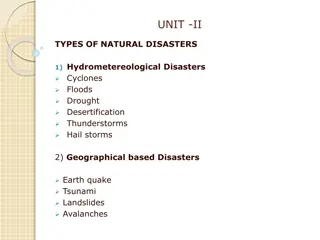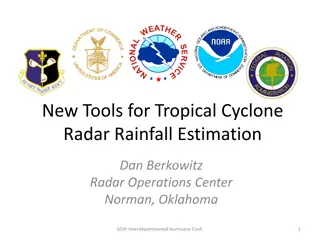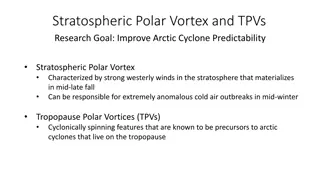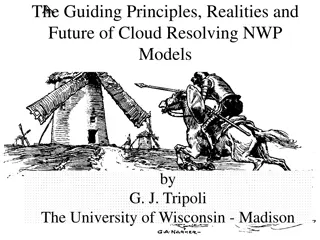CYCLONES AND ANTICYCLONES
This content delves into the concepts of cyclones, anticyclones, and the key forces driving atmospheric circulation. From pressure gradient force to Coriolis force, and the geostrophic and gradient winds, it covers the essentials of meteorology in a comprehensive manner. Exploring the influence of factors like isobars and wind speed, the visuals and explanations provided offer an insightful look into the mechanics of weather patterns.
Download Presentation

Please find below an Image/Link to download the presentation.
The content on the website is provided AS IS for your information and personal use only. It may not be sold, licensed, or shared on other websites without obtaining consent from the author.If you encounter any issues during the download, it is possible that the publisher has removed the file from their server.
You are allowed to download the files provided on this website for personal or commercial use, subject to the condition that they are used lawfully. All files are the property of their respective owners.
The content on the website is provided AS IS for your information and personal use only. It may not be sold, licensed, or shared on other websites without obtaining consent from the author.
E N D
Presentation Transcript
CYCLONES AND ANTICYCLONES
REVIEW OF KEY FORCES Pressure gradient force (PGF) High to Low Perpendicular to the isobars Proportional to isobar spacing Coriolis force (COR) Acts to right of parcel direction in N. Hemisphere (and to left in S. Hemisphere) Maximum at poles, zero at equator Proportional to wind speed
Geostrophic Wind (Vgs) Assumptions: 1) Straight isobars 2) No friction 3) Northern Hemisphere (unless told otherwise) L pgf 00 00 pgf Vgs 04 04 pgf PGF is constant cor cor 08 08 COR increases with Increasing wind speed cor cor pgf 12 12 H Geostrophic wind (Vgs) is constant speed; parallel to the isobars
Geostrophic Wind PH = PGF; C = COR
Geostrophic Wind As PGF increases, geostrophic wind speed increases.
(or low heights) Westerlies Aloft (or high heights) (or low heights)
Gradient Wind (Vgr) Assumptions: 1) No friction 2) Wind parallel to curved isobars 3) Northern Hemisphere (unless told otherwise) Geostrophic wind would blow across curved isobars Vgr Vgs For the wind to follow curved isobars, the inward force must be stronger than the outward force. In this case, PGF>COR. L pgf cor
Gradient Wind (Vgr) Assumptions: 1) No friction 2) Wind parallel to curved isobars 3) Northern Hemisphere (unless told otherwise) For the wind to follow curved isobars, the inward force must be stronger than the outward force. In this case, PGF<COR. Hcor pgf Vgr
Gradient Wind PGF = pressure gradient force CF = Coriolis force
Gradient Wind If PGF=COR, wind is not parallel to isobars If PGF>COR, gradient wind is parallel to isobars
Gradient Wind If PGF=COR, wind is not parallel to isobars If PGF<COR, gradient wind is parallel to isobars
Gradient Wind (Aside: Net = inward force minus outward force = centripetal acceleration)
Surface Wind (Vsfc) Surface wind (Vsfc) Geostrophic wind (Vgs) L L Vsfc pgf pgf Vsfc 00 00 00 00 Vgs fr fr 04 04 04 04 cor H H cor 1. Friction is directed opposite the wind. The result is a wind that blows across the isobars. Friction is always directed opposite the wind, and Coriolis is always to its right (in the Northern Hemisphere). 2. Friction reduces the wind speed. 3. Since Coriolis is proportional to wind speed, Coriolis is reduced. 4. Now the PGF>COR, so the surface wind will blow across the isobars toward low pressure.
Summary of Winds at Surface and Aloft Aloft (no friction) Gradient Gradient Geostrophic Surface (with friction)
Surface Gradient Vgr Vsfc cor L L cor pgf pgf fr fr cor cor H H pgf pgf Vsfc Vgr
Cyclones and Anticyclones Surface friction produces surface convergence and divergence.
Ekman Spiral L increasing friction pgf Vgs (no friction) cor H As friction increases (an air parcel gets closer to Earth s surface), the wind becomes more cross-isobaric and the wind speed declines (as does the Coriolis force).
Buys-Ballots Law If wind is at your back, low pressure is to your left.
Southern Hemisphere Winds at Surface and Aloft Cor Trough Ridge PGF
S. Hemisphere Surface Map
Cyclones Southern Hemisphere Northern Hemisphere (Chap. 8, pp. 214 224)
Quick SummaryCyclones and Anticyclones (Chap. 8): Geostrophic Wind (straight isobars, no friction) balance between PGF and COR wind is parallel to isobars Gradient Wind (curved isobars, no friction) inward force > outward force wind is parallel to isobars around a curved path cyclonic flow is counter-clockwise in N. Hemisphere and clockwise in S. Hemisphere Surface Wind (friction is present) friction reduces wind speed slower wind reduces COR flow is across the isobars toward low pressure more friction increases cross-isobaric flow


